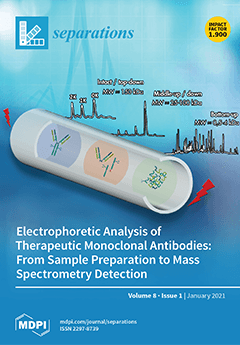A new dimeric sesquiterpene named disesquicin (compound
1) was isolated from
Inula racemosa roots by normal-phase MPLC (Medium Pressure Liquid Chromatography), and its structure was established by using extensive spectral analysis. Compound
1, when tested on different human cancer cell lines,
[...] Read more.
A new dimeric sesquiterpene named disesquicin (compound
1) was isolated from
Inula racemosa roots by normal-phase MPLC (Medium Pressure Liquid Chromatography), and its structure was established by using extensive spectral analysis. Compound
1, when tested on different human cancer cell lines, showed marked cytotoxic activity (IC
50 (µg/mL): 5.99 (MDA-MB), 9.10 (HeLa), and 12.47 (A549)). Docking study revealed that it binds at the catalytic domain of PLK-1 and interacts with catalytic site residues Leu59, Gly60, Lys61, Gly62, Cys67, Ala80, Lys82, Leu130, Arg136, Ser137, Leu139, Glu140, Lys178, Gly180, Asn181, Phe183, and Asp194. The binding of compound
1 to PLK-1 is spontaneous in nature as evident by a free energy of—8.930 kcal mol
−1, corresponding to a binding affinity of 3.54 × 10
6 M
−1. Results showed that compound
1 exhibited cytotoxic potential that was further confirmed by in vivo investigations.
Full article





